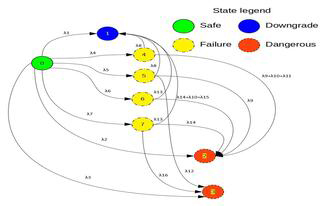
Aerial work vehicles are widely used in a variety of aerial work scenarios. In these vehicles, energy-saving is realized by telescopic motion control. Due to telescopic boom and person-mounting, their work safety requirements are very high. The anti-rollover protection function is one of their important active safety technologies, which is mainly realized through electrical, electronic, and programmable systems. At present, there is a lack of accurate and dynamic quantitative evaluation methods for functional safety level, and this problem can be solved by a quantitative evaluation method based on the Markov model. In this paper, the evaluation method for a safety system with a heterogeneous redundant structure based on the Markov model is first studied. Through this method, a Markov model is established for the active safety system of an aerial work vehicle, and its safety parameters such as safety and reliability are calculated through numerical simulation. In this way, the designed safety system is evaluated to meet the design requirements of functional safety, and the changing rules of the relevant parameters of the safety system are dynamically understood through Markov simulation. Finally, by this method, the probability of dangerous failure of a complex safety system can be simulated and calculated so as to accurately and quantitatively evaluate its safety parameters.
Jian Liu, Xiang Yang, "Quantitative Evaluation on Safety of Telescopic Boom Energy-saving Control System of Aerial Work Vehicle" in Journal of Imaging Science and Technology, 2024, pp 1 - 11, https://doi.org/10.2352/J.ImagingSci.Technol.2024.68.4.040506
 Find this author on Google Scholar
Find this author on Google Scholar Find this author on PubMed
Find this author on PubMed